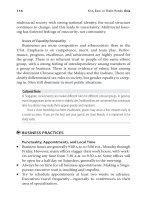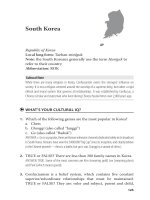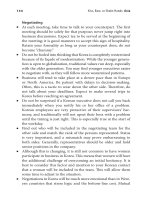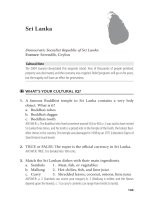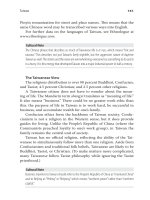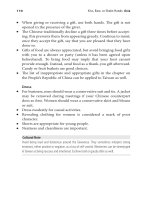Tài liệu How to Do Business in 12 Asian Countries 26 pdf
Bạn đang xem bản rút gọn của tài liệu. Xem và tải ngay bản đầy đủ của tài liệu tại đây (104.44 KB, 9 trang )
206
Kiss, Bow, or Shake Hands: Asia
●
Foreign consular oces in the United States
●
Key ocers at U.S. foreign service posts
www.customs.ustreas.gov
Produces a database that can be queried by topic, (e.g., travel
requirements, importing procedures, etc.), or an individual’s sta-
tus (e.g., importer, traveler, carrier, etc.)
www.cia.gov
e U.S. Central Intelligence Agency produces several documents
of note for global travelers. ese include:
●
e World Factbook (at www.cia.gov/cia/publications/factbook)
●
An online directory called “e Chiefs of State and Cabinet
Members of Foreign Governments,” available at www.cia
.gov/cia/publications/chiefs/index.html. is informational
directory is updated weekly and includes many governments
of the world, including some with which the United States
of America has no diplomatic exchanges, and which are not
ocially recognized.
Corruption and Bribery
www.transparency.org
Transparency International, a worldwide nongovernmental orga-
nization, reports on corruption and bribery around the world.
ey issue an annual “Corruption Perceptions Index,” which
relates to perceptions of the degree of corruption as seen by busi-
nesspeople, academics, and risk analysts. In the “2005 Corruption
Perceptions Index,” the ve least corrupt countries out of 158
were Iceland (number 1), Finland, New Zealand, Denmark, and
Singapore. e ve most highly corrupt were Haiti, Myanmar,
Turkmenistan, Bangladesh, and Chad (number 158).
Medical Information
www.cdc.gov/travel
e Centers for Disease Control provides an abundance of medi-
cal resources for international travelers. It includes everything
from health information and vaccinations required for specic
destinations, to advice on traveling with children and pets.
Of course, you will want to be thoroughly prepared for your
trip, so schedule physical and dental examinations well before
leaving. Remember that some vaccinations must be given over
a period of time. Also take current medical documentation with
you, and list any chronic conditions and current prescription
drugs (including dosages). In order to avoid problems at cus-
toms, carry all medications in their original containers. Also, take
an extra set of glasses, contacts, or prescriptions. In your bags,
include the name, address, and phone number of someone to be
contacted in case of an emergency.
Prepare a basic medical travel kit, which might include aspirin,
a topical antibiotic, bandages, a disinfectant, 0.5 percent hydro-
cortisone cream (for bites or sunburn), sunblock, a thermometer,
and diarrhea medication. Pack the kit in your carry-on luggage (if
you are permitted a carry-on bag!).
Also conrm that you have sucient travel medical insur-
ance. ere are two main types of travel insurance: 1) policies that
make direct payments for medical care and provide assistance,
and 2) policies that reimburse you for emergency expenses. (With
the latter option, you might have to pay the doctor or hospital
immediately—in local currency—and le a claim once you return
home.)
While we do not endorse any specic organizations, the Bureau
of Consular Aairs maintains an extensive list of Travel Insurance
Companies, as well as Air Ambulance, Med-Evac companies, and
Executive Medical Services. A list of these rms is available at
/>Appendix C
207
208
Appendix D
Avoiding Fashion Faux Pas
“D S” from country to country. One
person’s power suit is another’s poor taste, and none of us want to
distract potential clients with our wild attire.
Even mistakes in your accessories can be highly detrimental to
a prospective sale. For example, there’s the story of the Texan and
the Italian in Chile. A large Chilean rm was nearing the end of a
contract-evaluation process for oileld equipment. e Texan and
Italian CEOs both had bids in on the contract; both wanted the job.
When the nal negotiations approached, the president of the Chilean
rm asked to meet the short-list bidders before making his decision.
e CEO from Texas arrived for his meeting in Santiago wearing
an expensive light-gray suit. His jewelry a designer watch, a heavy
gold ring from his alma mater, a massive silver belt buckle, and a
pair of snakeskin boots. When the Italian arrived, he wore a dark,
well-tted suit, a subtle tie, and was devoid of jewelry. Although the
U.S. company actually had a broader line of products, the Chilean
awarded the contract to the Italian rm, and explains that “the
U.S. company’s products may have been nominally better than the
Italian’s, but I needed to trust the CEO of the company I was going
to work with. e ostentatious show of jewelry and the loud clothes
on the U.S. CEO indicated to me that he was in business to amass
personal wealth and had the poor judgment to show it.”
Chileans generally opt for more conservative clothing. Bright col-
ors and ashy fashions are not suitable, nor are eye-catching acces-
sories (lapel pins, etc.).
Obviously, rules of correct attire vary from country to country.
What is in good taste in Dallas may be totally wrong in Dubai or
Delhi. If you are traveling to any of the following Asian destinations,
consider the following cultural guidelines and try to outt yourself
aptly for each country.
●
China: Even casual wear is somewhat conservative. Revealing
clothing in a business environment may be oensive. In social
situations, jeans are acceptable for both men and women.
●
Japan: Never appear casual at work. Slip-on shoes are best, because
you remove them frequently. Tall women should eschew extremely
high heels to avoid towering over their Japanese counterparts.
●
India: Remember that some Hindus consider leather products
oensive (especially in temples). While many Hindus are very
tolerant of others’ beliefs, it is prudent to leave most of your nely
tooled leather belts, wallets, boots, and briefcases at home, and
invest in some high-quality fabric accessories.
In some countries, men remove their jackets at work, while in
other countries, executives usually do not loosen their ties or take o
their jackets while at the oce. Never be the rst to shed your jacket.
Colors of clothing can have signicant meaning around the world.
Some hues and patterns can set the wrong tone in certain locations:
●
Yellow is associated with illness in South Korea, and certain shades
of yellow are reserved for the royal families to wear in Malaysia.
●
White is a color of mourning in much of Asia.
●
Green hats (like the famous “John Deere” signature caps) carry
the connotation that you are a cuckold (your wife is cheating on
you) in certain parts of Asia. Don’t hand them out at exhibitions
or conferences!
In general, bright, vivid colors are not a good choice for business
apparel in any country. Your garments form a large part of people’s
rst impressions of you, so investing in suitable attire will allow your
clients to spend more time listening to what you say, rather than
looking at what you wear.
Appendix D
209
210
Appendix E
Holidays
E celebrates holidays, and little or no
work is conducted during these celebrations. However, holidays are
always subject to change. Governments frequently add, delete, or
move certain ocial holidays. Furthermore, the dates for many holi-
days do not fall on the same day in the Western (Gregorian) calendar
each year. is may be because they are dated using a calendar that
does not correspond to the Western calendar (for example, the Ara-
bic Hijra calendar is lunar, and is only 354 days long).
Some cultures use lunisolar calendars (for instance, the Hebrew
and Chinese calendars—although these two are not similar in other
aspects), and some have both the aspects of solar and lunisolar calen-
dars (for example, the Hindu calendar).
Actually, there are over twenty calendars in use around the world!
Indonesia is a good example of one country that uses multiple cal-
endars. ey include the Gregorian calendar, one which is similar to
the Islamic calendar, a calendar used primarily in Java, and several
others. In Java, when the h day of a month coincides on all the cal-
endars various celebrations take place (businesses are opened, babies
are named, etc.). is is because ve is an auspicious number—there
are ve sacred mountains, ve elements, and so forth.
Some holidays are purposefully consecutive, like “Golden Week”
in Japan. It allows for Japanese workers to enjoy extended vacations
and observe some important holidays together.
e work week may be dierent in various cultures as well. For
example, in the Muslim world, the Sabbath is celebrated on Friday.
Some Islamic nations have their “weekend” on ursday and Friday,
and their work week runs Saturday through Wednesday.



